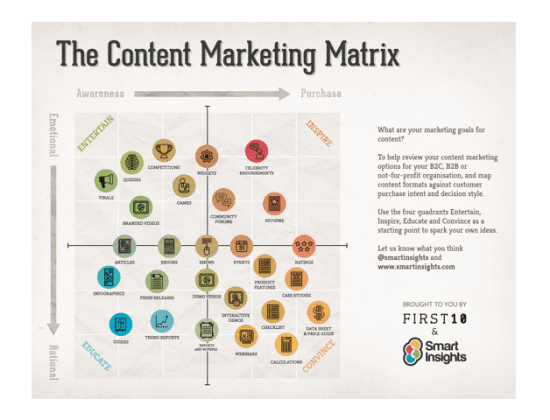5 SEO activities that integrate with your content marketing activities
Although SEO and content marketing are often still managed separately, there are many activities that overlap between them and some would even argue that a large part of SEO and content marketing are the same. Although I would consider SEO and content marketing to be different disciplines (at least at this stage in their respective evolutions), the lines between both activities are becoming increasingly blurred and opportunities to integrate SEO and content marketing should always be considered.
When planning content marketing activity, you should always consider the organic search benefits great content can bring if executed correctly. These are give specific techniques you can use to help ensure that SEO is supporting your content marketing efforts and vice-versa:
Whilst I firmly believe that great content should not be driven solely by SEO objectives (there are so many other great benefits that good content can drive), the popularity and use of keywords from search engines provide a sound indication of the types of topics, questions, ideas and solutions that people are searching for online.
As part of your content planning process, ask yourself the following:
- What personas/ audience type are you aiming to target?
- What type of content are the personas/ target audience interested in?
- What data does our keyword research indicate would make good content?
Keyword research takes time and effort as a key part of SEO planning and analysis and there are a number of advanced tools to assist with this process. But as a starting point consider these free tools to begin generating a top-level group of topics:
- Google Trends – to identify interest in topics by category and geography over time
- Google Keyword Planner – to get an idea of search volume for specific keywords and terms
- Ubersuggest – generate key phrase ideas using a range of ‘root’ terms, e.g. ‘how to open a current account online’
-
2. Integrating long-term and campaign planning
Both SEO and content marketing require a certain amount of long-term planning to ensure that activity is aligned with peaks in interest at different times of the year. Although this will be different for everyone, there is likely to be seasonal consistencies across the industry, so along with any specific focuses for your business, together these should be built into your overarching content plan.

The keyword research we looked at above should give you a good indication of the top terms and phrases people are searching for throughout the year. These can be used to begin outlining high-level themes and topics as part of an editorial calendar which will give you:
- A framework and process to plan and manage the creation of content
- Consistency and quality in your content
- Ability to align your team’s SEO and content marketing efforts
- Accountability for who does what and when
-
3. Focus on quality rather than quantity
When Google released their Penguin algorithm update in 2011, it was another clear signal that quality wins over quantity when it comes to effective search engine optimisation.
If you’re creating content to support social media, lead generation and brand engagement activity in addition to your SEO objectives, quality will continue to be a very important consideration.
The days of being able to create large quantities of low-quality content to obtain backlinks are over.
To inspire engagement and action from humans, content must be useful, helpful, educational or informative, or preferably all of these at once. The key is to begin with the end in mind and focus on adding something of value for the user.
Great content comes in many different shapes, sizes and forms, so think about your audience, the message you’re trying to get across and the best types of content for content marketing that work for your audience and the business:

-
4. Consider content distribution opportunities
It’s one thing to have great quality content but unless you effectively market and promote what you have then how will anyone be able to find and use it?
Effective content distribution is a key SEO activity and one that all content marketers should focus on to get their content seen, heard and viewed by the audiences they're intended for by ranking in the search results.
Some of the common activities to improve content distribution opportunities include:
- Ensure content includes relevant keywords and phrases naturally within the copy and main on-page SEO factors.
- Include social sharing buttons to allow users to easily favourite, bookmark and share your content with their social graph.
- Build your social media platforms and presence to create an engaged audience for your content.
- Look for opportunities to connect with influencers, bloggers, journalists and fellow marketers within your industry.
- Develop relationships with your media relations team and produce newsworthy content for key channels and publications.
- Guest post and blog on related websites and publications.
- Use your newsletter or email to syndicate a selection of your best content.
Many of the activities listed above will give you the ability to not only spread the word and raise awareness of your content but also generate inbound links to your site.
What used be called ‘link-building’ is now more a process of ‘link-earning’, and aligns very closely with influencer outreach or co-marketing with partners.
-
5. Reviewing content effectiveness
In order to review the effectiveness of your content, you’ll need to have a clear understanding of the metrics you’ll want to use to measure performance. There are many different KPIs for measuring content marketing, but it’s important to select the right ones for you based on your specific business goals and objectives.
Some common content marketing KPIs worth considering include:
- Organic search rankings/ traffic for top keywords
- Number and quality of inbound links
- Referring traffic from key social media sites and networks
- Social shares and bookmarks
- Sentiment
- Unique visits
- Engagement (bounce rate; time on page; pageviews)
Organic search rankings and traffic for top keywords can provide a good indication of what type of content is proving valuable to people. If the content you’re producing is relevant, engaging and follows SEO best practices, there’s a good chance this will get liked, shared and linked to, all of which will increase the content’s authority and presence within the search results.
As a result of Google’s decision to begin encrypting all organic search traffic data, it’s now much more difficult to track keyword-level data from web analytics. Knowing what keywords people have used to find your content is an important piece of data as it allows you to identify what keywords are driving traffic to particular pages and understand how searchers perceive content.
However, there are strategies and tactics to get hold of keyword-level data by using tools such as Webmaster Tools to enable you to review the effectiveness of your SEO and content marketing efforts.






